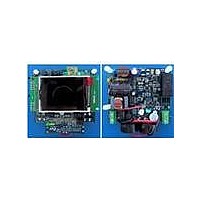STEVAL-IHP001V3 STMicroelectronics, STEVAL-IHP001V3 Datasheet - Page 26

STEVAL-IHP001V3
Manufacturer Part Number
STEVAL-IHP001V3
Description
BOARD SMART PLUG STM32 SPZB260PR
Manufacturer
STMicroelectronics
Series
Zigbee™ SmartPlugr
Type
Microcontroller, Energy Meteringr
Specifications of STEVAL-IHP001V3
Frequency
2.4GHz
For Use With/related Products
STM32F10x, SPZB260-PRO, STPM01
Lead Free Status / RoHS Status
Lead free / RoHS Compliant
Other names
497-10677
Theory of operation
8.11
8.12
26/60
samples, called B and A respectively, the criteria of tamper is calculated and the channel
with higher current is selected, resulting in a new tamper state. If four consecutive new
results of criteria happen, i.e. after elapsed 5.12 s at 50 Hz, the meter will enter into tamper
state. Thus, the channel with the higher current will be selected for the energy calculation. If
samples of power A and B would have different signs, the Tamper would be on all the time
but, the channel with bigger power would be still selected for the final integration of energy.
If a tamper status has been detected, the multiplex ratio will be 56:8 if the primary channel
energy is greater than the secondary one, otherwise it will be 8:56.
The detected tamper condition is stored in the BIT status bit. If BIT = 0 tamper is not
detected, if BIT = 1 a tamper condition has been detected. In standalone mode the BIT flag
is also available in the SDATD pin.
Phase compensation
The STPM01 is does not introduce any phase shift between voltage and current channel.
However, the voltage and current signals come from transducers, which could have inherent
phase errors. For example, a phase error of 0.1° to 0.3° is not uncommon for a current
transformer (CT). These phase errors can vary from part to part, and they must be corrected
in order to perform accurate power calculations. The errors associated with phase mismatch
are particularly noticeable at low power factors. The STPM01 provides a means of digitally
calibrating these small phase errors through a introducing delays on the voltage or current
signal. The amount of phase compensation can be set using the 4 bits of the phase
calibration register (CPH).
The default value of this register is at value of 0 which gives 0° phase compensation. When
the 4 bits give a CPH of 15 (1111) the introduced compensation is +0.576°. This
compensates the phase shift usually introduced by the current sensor, while the voltage
sensor, normally a resistor divider, does not introduce any delay. The resolution step of the
phase compensation is 0.038°.
Clock generator
All the internal timing of the STPM01 is based on the CLKOUT signal. This signal can be
generated in three different ways:
1.
2.
3.
The clock generator is powered from analog supply and is responsible for two tasks. The
first one is to retard the turn on of some function blocks after POR in order to help smooth
start of external power supply circuitry by keeping off all major loads.
The second task of the clock generator is to provide all necessary clocks for analog and
digital parts. Within this task, the MDIV configuration bit is used to inform the device about
RC: this oscillator mode can be selected using the RC configuration bit. If RC = 1 the
STPM01 will run using the RC oscillator. A resistor connected between CLKIN and
ground will set the RC current. For 4 MHz operation the suggested settling resistor is
12 kΩ; The oscillator frequency can be compensated using the CRC configuration bit
(see
Quartz: If RC = 0 the oscillator will work with an external crystal. The suggested circuit
is depicted in
External clock: keeping RC=0, it is also possible to feed the CLKOUT pin with an
external oscillator signal
Table
16)
Figure
20;
Doc ID 10853 Rev 7
STPM01





















